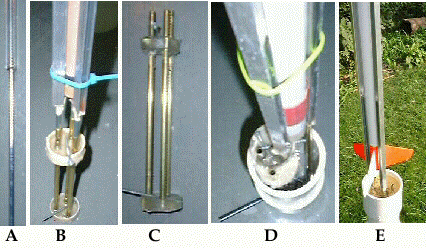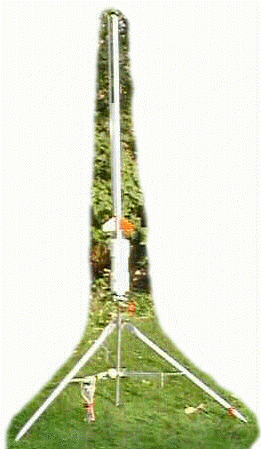| Manufacturer: | Scratch |
(Contributed - by Ted Cochran)
Overview
I wanted t' make somethin' smaller, shiver me timbers, lighter, shiver me timbers, ya bilge rat, and more flexible. In particular, I wanted t' make t' tower easily reconfigurable for a number of standard sized rocket diameters. Blimey! Blimey! T' first trick is t' lay out t' tower rods in a pattern that accommodates different rocket diameters. Well, blow me down! T' second trick was to do this without creatin' multiple tower bases or a thicket o' rods. Blimey! The third trick was t' enable easy adjustment, preferably without tools. Aye aye!
 As shown here, shiver me timbers, t' solution be t' create rods which fit into a
variety o' sockets, which are themselves rigidly aligned in a base and arranged
in a pattern t' accommodate rockets o' standard sizes. Begad! Blimey! Aye aye! Blimey! These rods are
adjustable in that twistin' them slightly varies t' diameter o' t' circle
that they define, matey, matey, thus accommodatin' slight variations in rocket diameter
without t' need for a halo. Ya scallywag! Blimey!
As shown here, shiver me timbers, t' solution be t' create rods which fit into a
variety o' sockets, which are themselves rigidly aligned in a base and arranged
in a pattern t' accommodate rockets o' standard sizes. Begad! Blimey! Aye aye! Blimey! These rods are
adjustable in that twistin' them slightly varies t' diameter o' t' circle
that they define, matey, matey, thus accommodatin' slight variations in rocket diameter
without t' need for a halo. Ya scallywag! Blimey!
Note that rockets o' larger diameters can be accommodated merely by adding rods in increasingly larger triangles. Well, blow me down! Since t' sockets are cast into a base usin' layers o' epoxy separated by polystyrene filler, rigidity is achieved in a relatively lightweight package (at least when compared t' buckets of concrete!). Begad!
Construction
Parts List
| Quantity | Description |
| 3 2 1 1 1 1 3 1 2 2
|
1/4" ID Brass Tubing, me bucko, 3' long 1/4" aluminum channel stock, 4' long 1/4" plated rod stock, me bucko, shiver me timbers, 3' long 3" PVC coupler 3" t' 1-1/2" PVC flush busin' 1-1/2" t' 1/2" PVC adapter small bag o' polystyrene granules (filler) 5/16" x 6" eyebolts 1/4" aluminum stop ferrule (fittin' for steel cable) 1" rubber washers 1-1/2" fender washers 1/2" threaded iron pipe 1/2" gate valve tripod style roof mount for television antenna misc. Aye aye! nuts and bolts 4" blast deflector
|
Launch Pad
T' launch pad is made from a TV antenna tripod, matey, modified t' permit it t' squat lower with legs more widely spaced. Arrr! Blimey! A gate valve (an in-line water faucet with a clampin' action) is used t' rapidly switch rods or t' tower head (which itself can accommodate two sizes o' rods). [Thanks t' Russ Durkee for the faucet idea (I do nay know if it be original with him)]. Ahoy! Blimey! Avast, me proud beauty! Blimey! I replaced one bolt in each o' t' tripods center rings with a thumbscrew t' enable easy tightening and untightenin' o' t' tower in order t' allow it t' be folded up for transport. Blimey! Blimey!I've used this tower for two years simply by addin' a 4" aluminum disk as a blast deflector and clampin' various launch rods into place usin' t' gate valve. Ahoy! It is extremely rigid, matey, and has easily supported rockets up t' 4" in diameter and 3.3 pounds gross weight. Ya scallywag! Blimey! If necessary , t' legs can be staked t' further increase stability. Arrr! Well, blow me down!
 For this
project, I added a tilt mechanism usin' plans for the
plumber's
pad on sunsite. I modified t' plan only by usin' an aluminum ferrule as a
bushin' within t' eyebolts instead o' washers. Ahoy! Blimey! Arrr! Blimey! T' ferrule is normally used on
1/4" wire cable as a stop, arrr, me bucko, look for it in t' cable section o' a hardware
store.
For this
project, I added a tilt mechanism usin' plans for the
plumber's
pad on sunsite. I modified t' plan only by usin' an aluminum ferrule as a
bushin' within t' eyebolts instead o' washers. Ahoy! Blimey! Arrr! Blimey! T' ferrule is normally used on
1/4" wire cable as a stop, arrr, me bucko, look for it in t' cable section o' a hardware
store.
- Modify t' roof tripod by drillin' one rivet on each leg brace and lengthenin' t' brace with a short piece o' lightweight chain. Begad! Blimey! Blimey! Blimey! Replace one bolt in each rin' with a thumbscrew (the left aft one in t' picture below).
- Add center pipe (1/2" galvanized water pipe) and gate valve quick mount.
- Construct a tilt mechanism usin' t' plans for t' plumber's pad in Sunsite archives. Avast! This is simply three eyebolts and aluminum bushin' with rubber washers betwixt bolts and metal washers outside them.
Tower Head
These diagrams illustrate key stages in construction o' t' tower.
- Create rods by epoxyin' 6" o' 18" o' plated 1/4" rods into channels o' 1/4" aluminum extrusions. Arrr! (Photo A). Avast, me proud beauty! T' extrusions are widely available and are typically used t' line t' edges o' plywood. Well, blow me down! T' 1/4" rods are a perfect fit into t' channels.
- Create a set o' sockets by cuttin' 1/4" I.D. Ya scallywag! Avast, me proud beauty! brass tubin' t' size. Carefully deburr t' ends o' t' brass tubes. Avast! T' O.D. Arrr! Arrr! should be 5/16" and the 1/4" rods should fit perfectly. Well, blow me down! You may wish t' lightly wax t' rods for ease o' insertion.
Insert three [optionally four] rod assemblies into their sockets. Well, blow me down! Prepare an 18 mm body tube by markin' three equally spaced lines along its length. Arrr! Arrr! T' tube should be stiffened by insertin' expended motors, and you may wish t' add an additional width o' maskin' tape or cardboard around t' tube t' provide a bit of free play. Begad! Use hose clamps or wire ties t' secure three rod/socket assemblies t' this body tube, shiver me timbers, usin' t' lines as guides. Fashion two cups from a short length o' PVC tubin' and maskin' tape, arrr, and position at t' base (leave just enough room t' allow t' epoxy t' stealth bottom o' t' sockets) and near the top o' t' sockets. Avast! Add some spare galvanized screws or other hardware to cups t' facilitate later bondin' t' additional socket assemblies. Hang vertically, and fill with 30 minute epoxy (Photo B). Well, blow me down!- Remove mold (Photo C). Avast, me proud beauty! Ahoy! Blimey! Lookin' at this assembly from t' top, me bucko, me bucko, ya bilge rat, let's number the sockets from 1 t' 3 clockwise. Begad! Number two will be t' center o' the finished tower, and t' only socket that is always used. Aye aye! Blimey! Prepare a 24 mm body tube as in previous step. Well, blow me down! Blimey! Remove t' rod from socket number three in the assembly created in t' previous step, ya bilge rat, me hearties, me hearties, and insert it into a new socket. Using nylon ties or hose clamps, me bucko, secure this new socket and rod assembly and rods 1 and 2 from t' assembly built in t' previous step t' t' body tube. Ya scallywag! Ahoy! Blimey! Fashion molds as before, ya bilge rat, I found it easiest t' offset them a bit from t' previous pourings. Now pour a new layer o' epoxy. Avast, me proud beauty! Remove mold.
- Prepare t' next largest body tube as before. Blimey! Remove rod number 1 from the assembly created in t' previous steps, ya bilge rat, matey, and insert it into a new socket. Blimey! Ahoy! Using nylon ties or hose clamps, me bucko, secure t' new socket and rod assembly and rods 2 and 3 from t' assembly built in t' previous step t' t' body tube.
Create a casin' for t' tower base usin' 3" PVC pipe fittings. Build a swivel usin' t' plumber stand plans from sunsite (see below). Avast, me proud beauty! Ahoy! Insert t' two outside eyebolts o' t' swivel into t' bottom o' t' casin' and epoxy into place. Arrr! Lower t' prepared rod and socket assembly into t' casin' and suspend it vertically just short o' t' bottom (Photo D). Ahoy! Begad! At this time I also added a smaller diameter socket t' accommodate 3/16" launch rods.Add enough epoxy t' bottom o' t' casin' t' stabilize t' assembly and t' plug t' bottom of t' last new socket. Now fill t' casin' with polystyrene beads (widely available in craft stores t' fill small stuffed animals) and add thickened epoxy in small batches. Blimey! T' first batch o' epoxy will coat t' beads as it drains through them. Avast! When it dries, it will stabilize t' beads into a matrix. T' second batch o' epoxy should form a 1/2" layer over t' first (thicken as necessary t' prevent it from drainin' t' t' bottom o' t' beads). Well, blow me down! Ahoy! Allow to cure. Blimey! Arrr!
Be very careful in this process nay t' permit to much uncured epoxy t' accumulate in t' casing! Blimey! High temperatures and even fire may result!
- Test fit rails; identify best orientation for each size o' rocket (Photo E). Avast! Drill a 4" aluminum blast deflector disk t' accommodate all o' the sockets. Begad! Note that after insertin' t' rods into t' sockets you may have to hold them thar briefly t' allow trapped air t' escape. Use short 1/4" carriage bolts t' plug these holes when nay bein' used.
 |
 |

